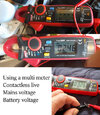Hi All,
Some weeks ago one of our ceiling lights stopped working.
It’s one of those where 3 switches operate it, in our main corridor.
With a multimeter I tested the fixture which holds 3 Compact Fluorescent Light Bulbs.
The bulbs themselves are all fine (tested in a different room).
Removing the fixture and exposing the cables I measured a strange voltage value… around 50V!!!???
I opened one of the switches and it was a 4 way. Opened a second one and also a 4 way. The last one is a 3 way.
The house is about 9 years old and this has worked since day one, not sure what happened.
Measuring the voltage on the 4 way switches shows a strange 147V. if I switch the switches (using their buttons) I can get up to 200V, yes, not higher than that. I tested this with 2 different meters.
Could one of the switches be faulty causing this? What else could cause this strange voltage reading? Nothing else was tripped nor behaving differently, just this particular staircase system.
Any idea of what this might be or tips to further diagnose?
Some weeks ago one of our ceiling lights stopped working.
It’s one of those where 3 switches operate it, in our main corridor.
With a multimeter I tested the fixture which holds 3 Compact Fluorescent Light Bulbs.
The bulbs themselves are all fine (tested in a different room).
Removing the fixture and exposing the cables I measured a strange voltage value… around 50V!!!???
I opened one of the switches and it was a 4 way. Opened a second one and also a 4 way. The last one is a 3 way.
The house is about 9 years old and this has worked since day one, not sure what happened.
Measuring the voltage on the 4 way switches shows a strange 147V. if I switch the switches (using their buttons) I can get up to 200V, yes, not higher than that. I tested this with 2 different meters.
Could one of the switches be faulty causing this? What else could cause this strange voltage reading? Nothing else was tripped nor behaving differently, just this particular staircase system.
Any idea of what this might be or tips to further diagnose?



